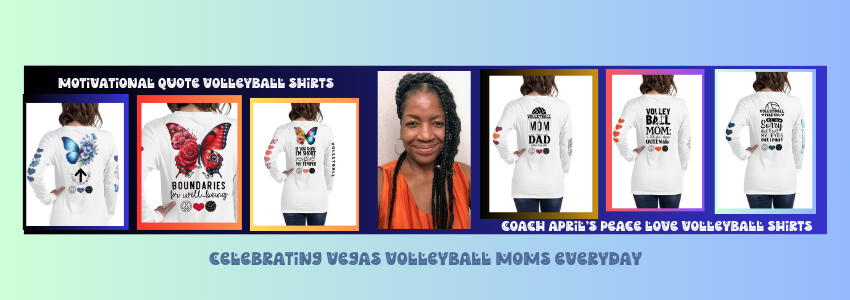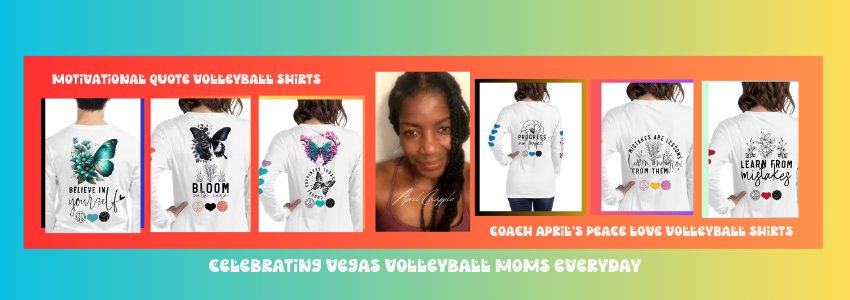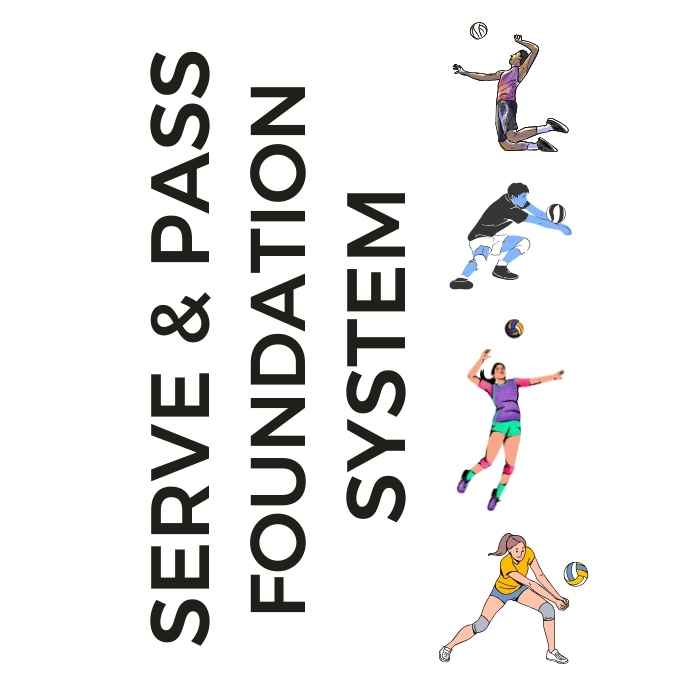
Serve + Pass Foundation System: The Complete Skills Arsenal The two-skill mastery system that transforms inconsistent players into the athletes coaches build their lineups around. Stop Struggling With The Two Most Important Skills In Volleyball!
- Improve Your Volleyball with Coach April
- Questions For Volleyball Players
- Varsity Volleyball Block Training
Volleyball Block Training Learn 3 Ways Blockers Stay Ready At The Net
Volleyball Block Training: Learn 3 ways to block more balls by staying an arm's length away from the net, stay square to the net and how to take cross court.
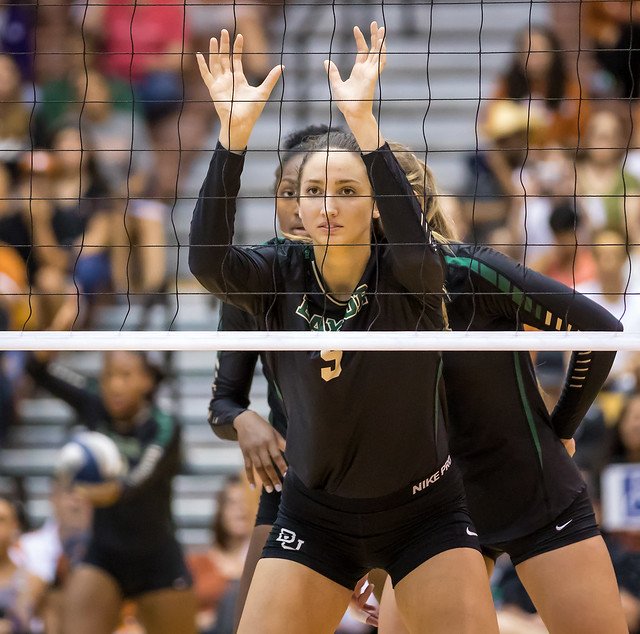 Volleyball Block Training: Stay an arm's length away from the net, stay square to the net, take hitter's cross court, read hitters early to position yourself to block faster. (Aversen)
Volleyball Block Training: Stay an arm's length away from the net, stay square to the net, take hitter's cross court, read hitters early to position yourself to block faster. (Aversen)What's a good blocker volleyball ready position?
- stay an arm's length away from the net
- stay square to the net
- take an outside hitter's cross court away if you don't have a specific game plan
- read the hitter earlier to position yourself earlier
Learn Volleyball Blocking Footwork - Learn How To Swing Block Like We Do in Semi Private Training
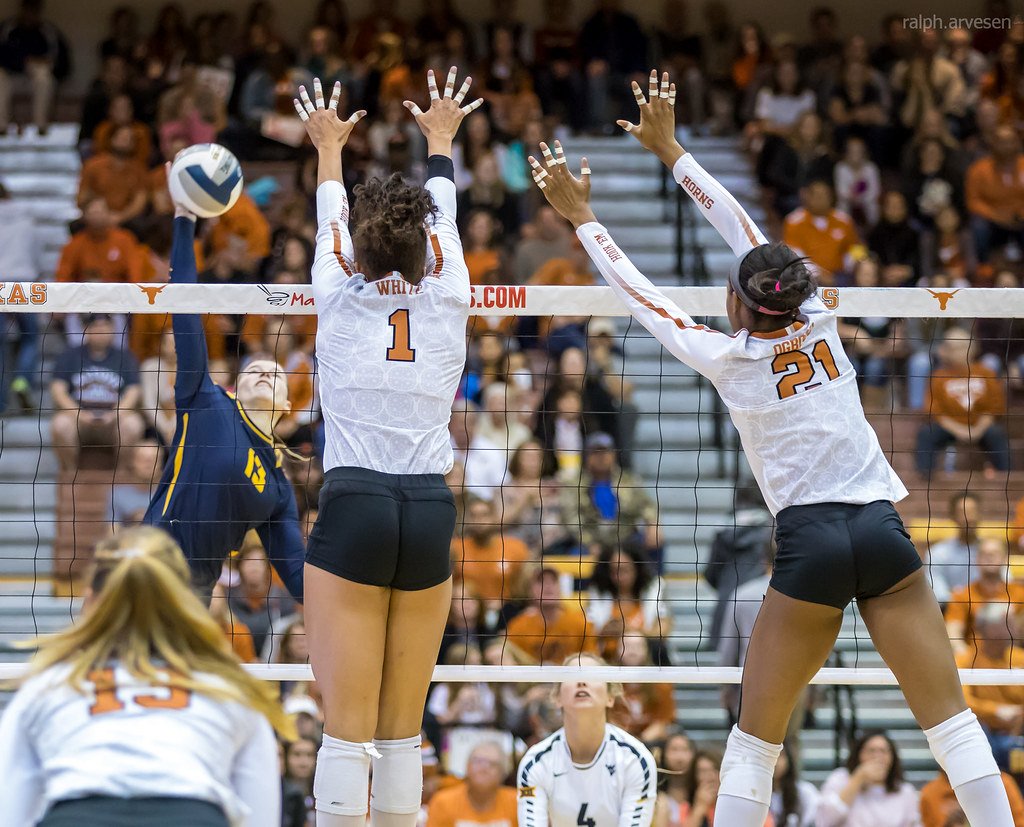 Volleyball Block Training: Stay an arm's length away from the net, stay square to the net, take hitter's cross court, read hitters early to position yourself to block faster. (Aversen)
Volleyball Block Training: Stay an arm's length away from the net, stay square to the net, take hitter's cross court, read hitters early to position yourself to block faster. (Aversen)A Volleyball Block Training Guide To A Better Blocker Volleyball Ready Position
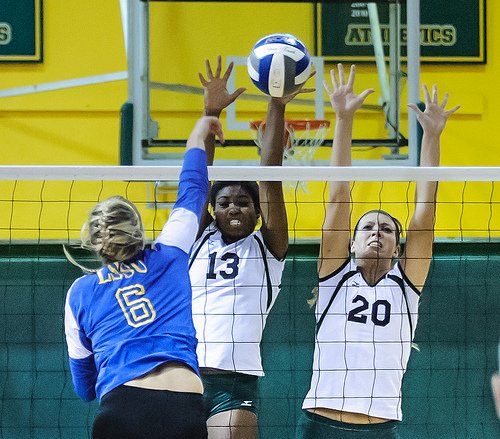 Volleyball Block Training: Good volleyball block positioning is essential for being able to consistently stop an attacker's ball at the net. (CE Andersen)
Volleyball Block Training: Good volleyball block positioning is essential for being able to consistently stop an attacker's ball at the net. (CE Andersen)Good volleyball block positioning is essential for being able to consistently stop an attacker's ball at the net.
Volleyball Block Training
Stay Half Your Arm's Length Away From The Net
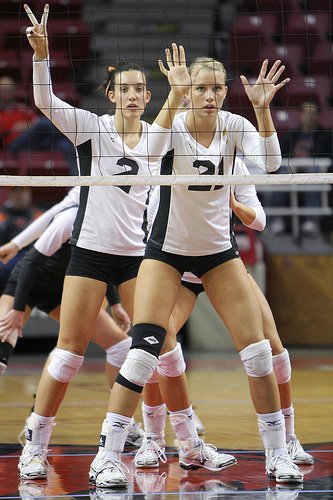 Volleyball Block Training: And while you are blocking a volleyball at the net, you always want to know how far you are away from the net you are when you step away from it. (Bill Shaner)
Volleyball Block Training: And while you are blocking a volleyball at the net, you always want to know how far you are away from the net you are when you step away from it. (Bill Shaner)When you're blocking a volleyball you want to position yourself..half your arm’s length away from the net.
That’s an easy measurement that you can make quickly when you have rotated up to the front row and you're waiting for the referee to blow their whistle which starts the rally.
Do you know why I say half the length of your arm?
Because half the length of your arm measures out to be the same distance it takes for you to take one step.
It’s an easy way to measure one of your steps.
And while you are blocking a volleyball at the net, you always want to know how far you are away from the net you are when you step away from it.
Volleyball Block Training
Stay Squared to The Net
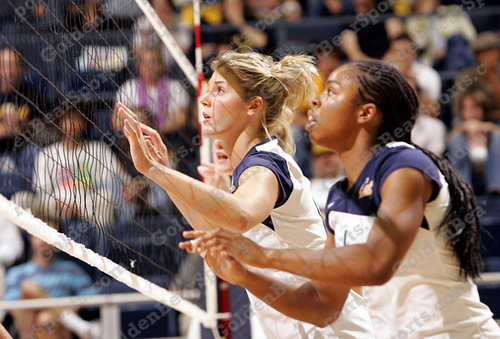 Volleyball Block Training: Stay Squared to The Net - You want your hands to stay just above your shoulders, with your palms facing the net. (Avinash Kunnath)
Volleyball Block Training: Stay Squared to The Net - You want your hands to stay just above your shoulders, with your palms facing the net. (Avinash Kunnath)Remember this, it’s very important that your shoulders remain squared to the net as well.
Since your shoulders get your arms over the net, and to utilize every inch of your arm length when you are blocking, you want to make sure your shoulders are facing the net.
You want your hands to stay just above your shoulders, with your palms facing the net.
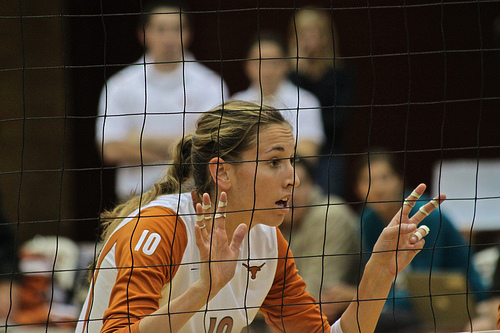 Volleyball Block Training: Stay Squared to The Net - You want your hands to stay just above your shoulders, with your palms facing the net.
Volleyball Block Training: Stay Squared to The Net - You want your hands to stay just above your shoulders, with your palms facing the net.It takes time to get your hands up and over the net so your blocking ready position for your hands should be at a midway point so that you don't waste precious time bringing them from a low position.
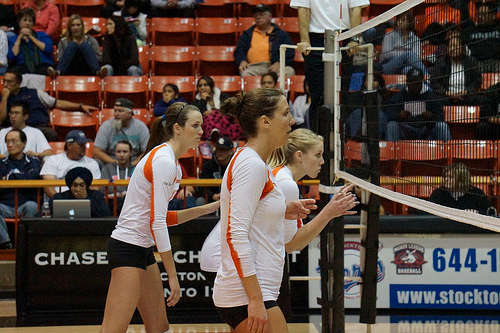 It takes time to get your hands up and over the net so your blocking ready position for your hands should be at a midway point so that you don't waste precious time bringing them from a low position.
It takes time to get your hands up and over the net so your blocking ready position for your hands should be at a midway point so that you don't waste precious time bringing them from a low position.In other words when you are blocking a volleyball at the net don’t have your hands down by your waist.
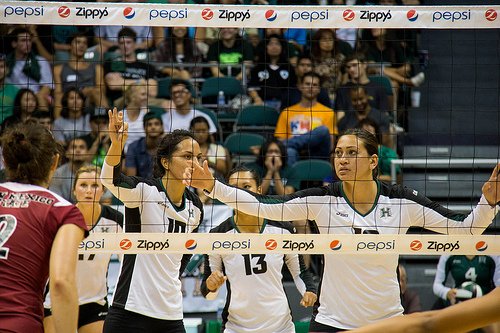 Volleyball Block Training: In other words when you are blocking a volleyball at the net don’t have your hands down by your waist. (Gov Neil Abercrombie)
Volleyball Block Training: In other words when you are blocking a volleyball at the net don’t have your hands down by your waist. (Gov Neil Abercrombie)Volleyball Block Training
Take A Outside Hitter's Cross Court
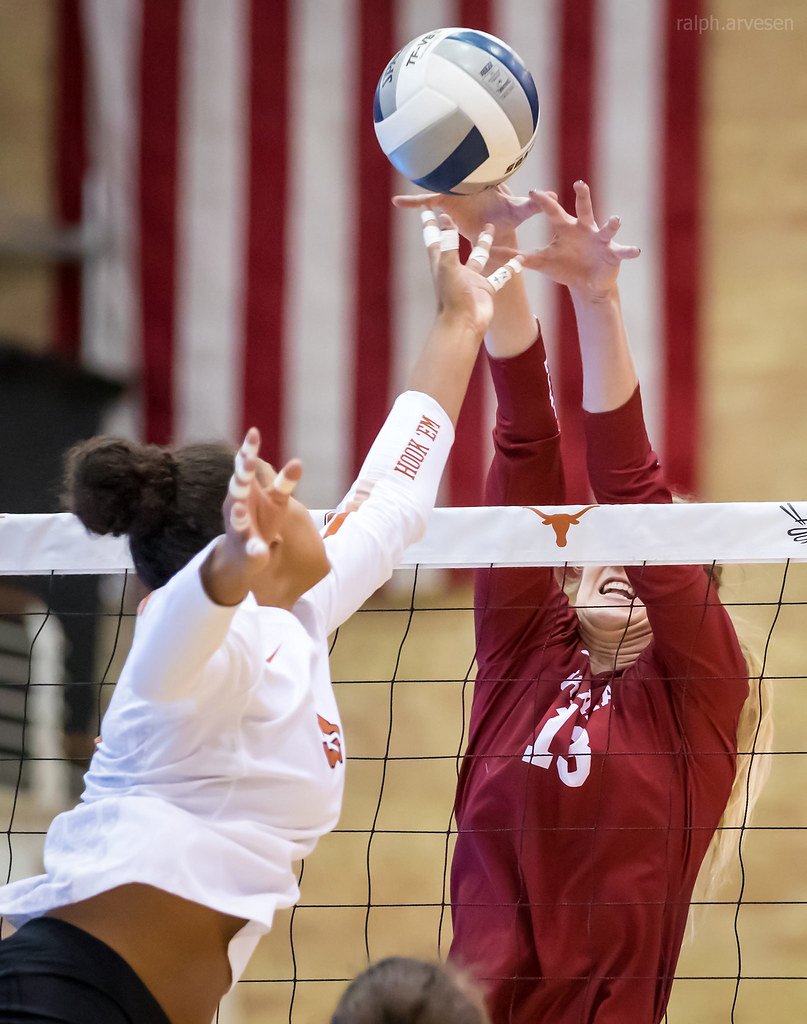 Volleyball Block Training: Unless your coach has established a different strategy, you want to line up in front of the hitter so that your block will take away her cross court hit. (Aversen)
Volleyball Block Training: Unless your coach has established a different strategy, you want to line up in front of the hitter so that your block will take away her cross court hit. (Aversen)Unless your coach has established a different strategy, you want to line up in front of the hitter so that your block will take away her cross court hit.
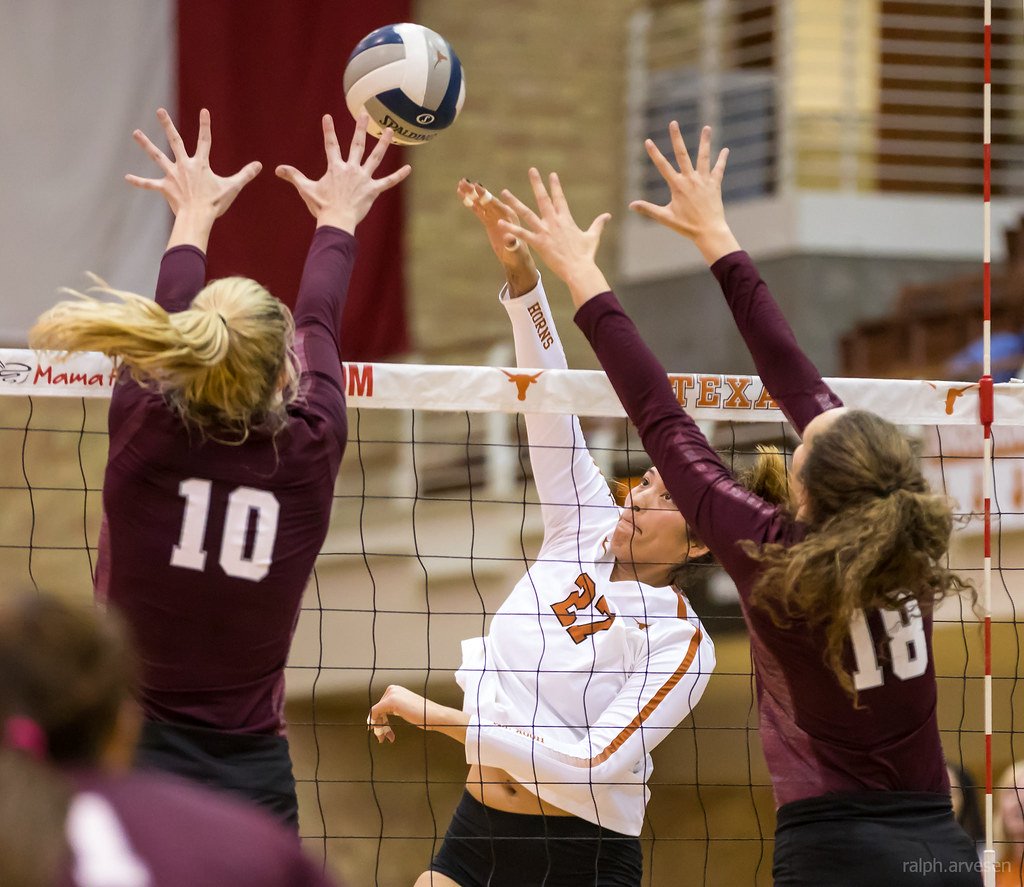 Blocker Volleyball Ready Position: Take A Outside Hitter's Cross Court: Line up in front of the hitter to block the extension of your spiker's arm and take away their angle.
Blocker Volleyball Ready Position: Take A Outside Hitter's Cross Court: Line up in front of the hitter to block the extension of your spiker's arm and take away their angle.You would take one or two side steps, which are also called lateral steps that would line you up in front of the hitter and you should prepare yourself to block the extension of your spiker's arm taking away their ability to hit the angle.
Why?
Most hitter's hit cross court more than they hit down the line because there's more volleyball court area to hit to.
If you know this and your coach hasn't given you a specific game plan about a certain hitter, then its best to take away the largest part of the court area that a hitter will most likely hit to.
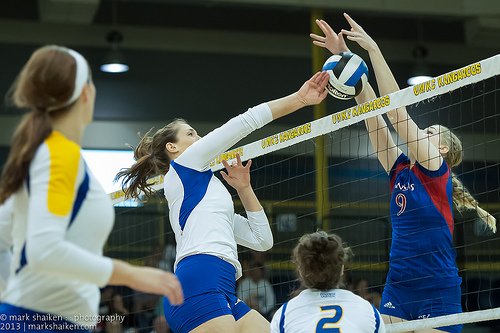 Blocker Volleyball Ready Position: Take A Outside Hitter's Cross Court: Most hitter's hit cross court more than they hit down the line because there's more volleyball court area to hit to. (ShakesKC)
Blocker Volleyball Ready Position: Take A Outside Hitter's Cross Court: Most hitter's hit cross court more than they hit down the line because there's more volleyball court area to hit to. (ShakesKC)On the other hand, let’s say your spiker's approach is more of a straight line, meaning they haven’t swung outside the court as much at an angle to take their spike approach.
When this happens there’s a greater chance that the hitter plans to hit the ball down the line.
So now you want to make sure that your body is squared up in front of them, and that you are prepared to block the extension of their arm.
Volleyball Block Training:
Read Your Hitter Early
In the volleyball block drills you do in practice, it’s a good idea to dedicate some time not only on your blocking technique but also on learning how to read your hitter.
You can make yourself into a better blocker if you can
- identify early enough the difference between what it looks like when the opposing team's hitter takes a cross court approach and
- what it looks like when they decide to hit down the line
- so you can position yourself earlier to block accordingly.
You can make yourself into a better blocker if you can identify early enough the difference between what it looks like when the opposing team's hitter takes a cross court approach and what it looks like when they decide to to hit down the line.
And can position yourself accordingly.
Here's something to do in your practice, when your team breaks up into two squads that have to compete against each other.
When you can identify what the hitters on your team do when they are about to hit cross court and you start blocking their balls pretty consistently, it won’t take long to trust your instincts and to start reading and blocking the hitters on opposing teams.
Once you learn and improve your volleyball blocker ready technique and timing, the next part of the blocking skill to master is just knowing what to look at, trusting what you see, and making adjustments accordingly.
Do You Follow Me on Pinterest?
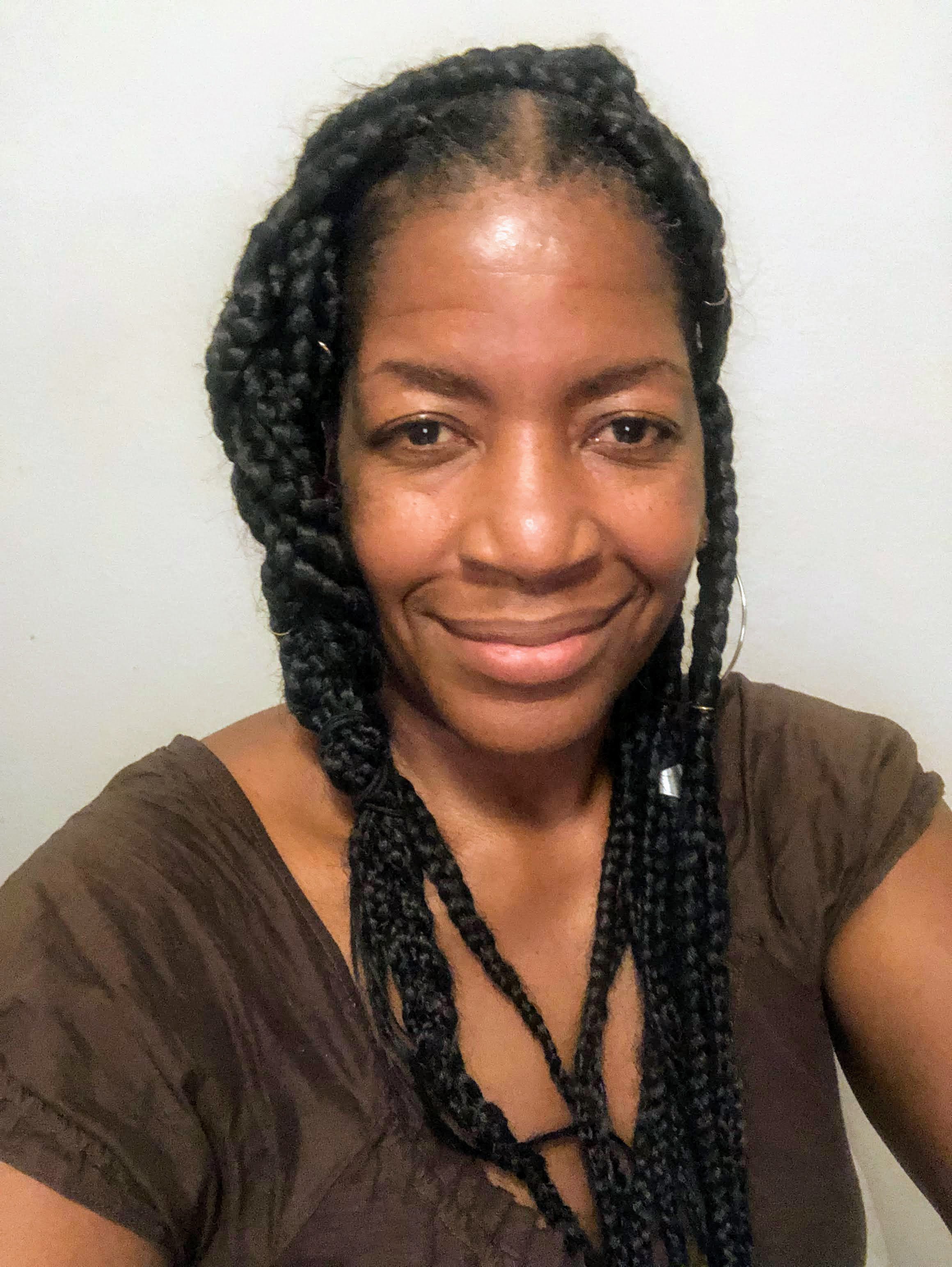 Private or semiprivate volleyball indoor/sand lessons are an excellent way for young Las Vegas high school volleyball players to quickly improve their individual skills through a private or semi-private coaching experience.
These lessons are conducted by former pro volleyball player, former USA Volleyball High Performance instructor and Evaluator and Tstreet Vegas 18s head Coach April Chapple on a weekly basis.
Sign up now!
Private or semiprivate volleyball indoor/sand lessons are an excellent way for young Las Vegas high school volleyball players to quickly improve their individual skills through a private or semi-private coaching experience.
These lessons are conducted by former pro volleyball player, former USA Volleyball High Performance instructor and Evaluator and Tstreet Vegas 18s head Coach April Chapple on a weekly basis.
Sign up now!Follow me on Pinterest Volleybragswag to improve your game even faster!
I share alot of individual, partner and easy-to-do volleyball serving drills we do in class with my followers.
Many of these volleyball practice drills you can do at home by yourself or try at your next practice with your teammates.
If you're a B team or JV player trying to make varsity next year...your goal should be to complete 1000 reps a day of at least three of the basic skills on your own...volleyball passing, serving and setting should be at the top of the list.
Volleyball Block Training:
Where Do You Go From Here?
What do you need to do now? You have three options:
- Learn more about Ready Positions
- Follow the suggested reading on our Sitemap page Learning How To Play (Sitemap)
- Or visit the pages in the Volleyball Skills section in the drop down menu at the top of the page to get started.
If your athlete struggles with consistent serve receive, gets subbed out, or is overlooked for playing time—this is the fix you’ve been looking for.

Struggling with passing consistency?
I help talented passers tired of getting pulled from games because of inconsistent serve receive skills BUILD passing confidence without expensive private lessons using the same 3-step system that's helped dozens of my athletes get recruited.
Download my eBook for $17.99 and start building the passing confidence that keeps you on the court—and gets you seen by college coaches.
From Lady Vol to Legend: Coach April Produces Powerful Passionate Players...is that you?
What Are You Looking For?
Click to Download Your Pre Serving Ritual Mastery Checklist pdf:
🎯Volleyball Pre Serving Ritual Guide -
Players! Learn How To Transform Your Serve from Weak to Weapon
Click to Download Your Parent's Volleyball Serving Checklist pdf
🎯Parent's Volleyball Serving Checklist Guide
Parents! Help Your Player Develop Championship Serves (Even If You've Never Played)
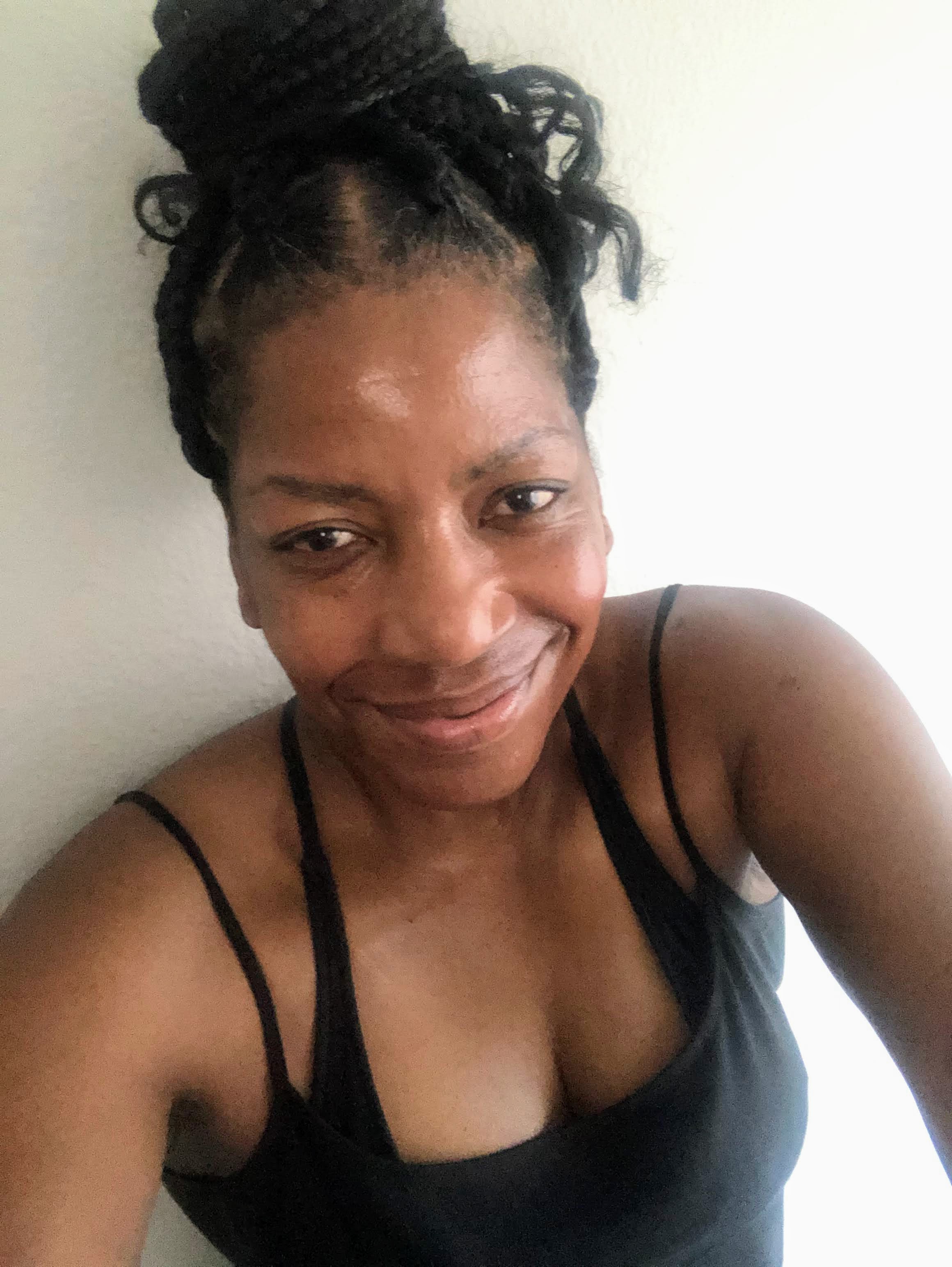
Hi there!
Thanks for stopping by. Hope you learned something today that will help you reach your volleyball goals.
Be sure to subscribe to my email newsletter so you can learn more each week!
Stay strong! Stay motivated!
-Coach April
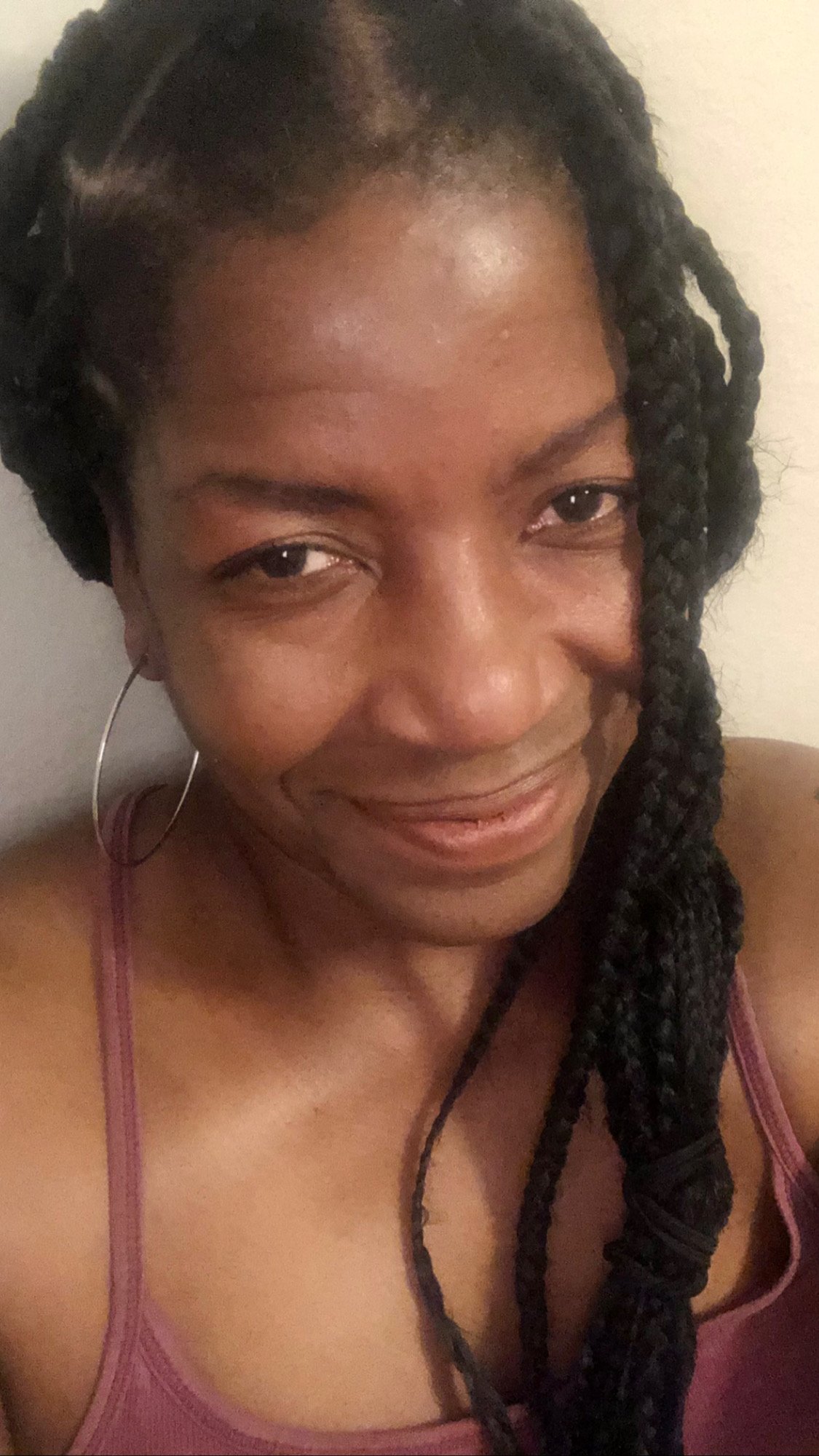
SUSCRIBE to my email newsletter below!
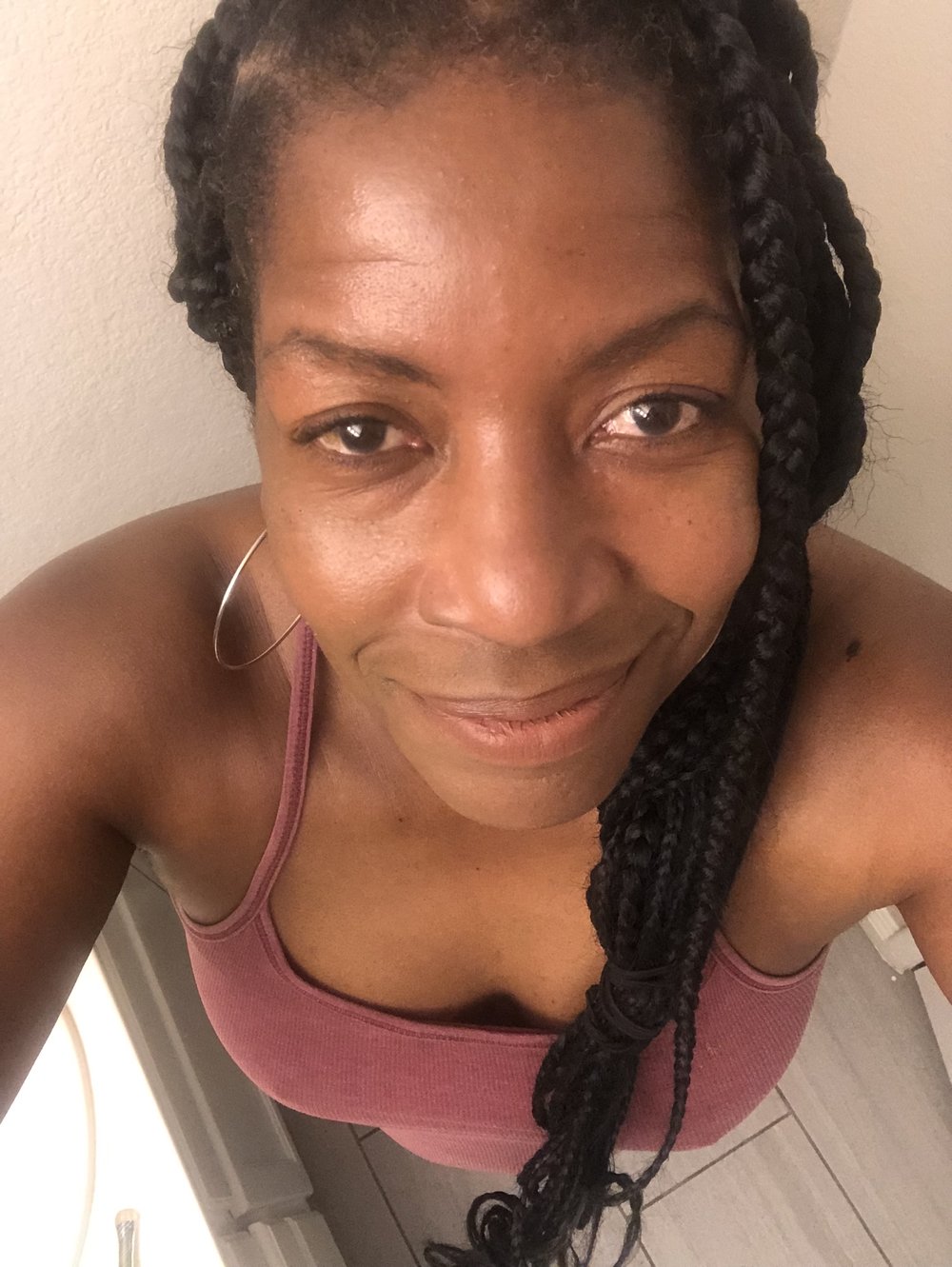 Click to learn more about the weekly volleyball classes and clinics or email info@imrpoveyourvolley.com for information
Click to learn more about the weekly volleyball classes and clinics or email info@imrpoveyourvolley.com for informationCongratulations to my seven Boys-18s Vegas Volley club players who played in two state championship finals yesterday, the 3A and 5A State champinship finals at Sunrise Mountain High School.
TOURNAMENT CHAMPIONS!
A-1 Vegas Volley VBC
In It To Win It Tournament
May 2 - 4, 2025 Tournament
Gold Medalists
18s Premier Division
Vegas Volleyball's Unsung Heroes: Celebrating Moms with Peace Love Volleyball Shirts
Ready to energize your volleyball mom journey?
Subscribe to my 'Producing Powerful Passionate Peaceful Players' email list above on ImproveYourVolley.com.
You'll receive energy-boosting tips, exclusive insights from me, Coach April Chapple on maintaining momentum in volleyball.
Let's power up the Vegas volleyball scene together!
Recent Articles
-
5 Essential Serving Tips from Tennessee's #2 Career Aces Record Holder
Dec 09, 25 11:39 PM
I've identified the 5 essential serving tips that separate confident servers from struggling ones and you'll serve with the confidence that creates aces -
The Volleyball Toss How Consistent Is Your Ball Toss Before You Serve?
Dec 07, 25 12:29 AM
The volleyball toss for the overhand serve needs to consistently be two feet up in the air and one foot in front of front foot which puts the ball in front of your serving arm. -
Shop Small: Real Volleyball Training With + Results From A Real Coach
Dec 03, 25 10:30 AM
Support a woman-owned business. Get training from a former elite pro with 13+ years coaching experience. Ditch the big box store--invest in proven results.
